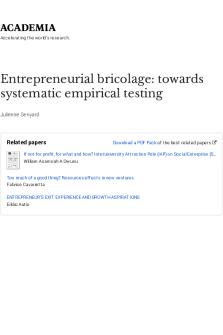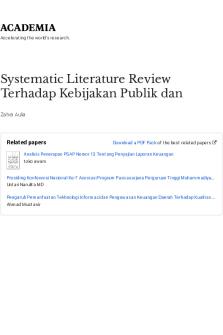Systematic Mineralogy PDF

| Title | Systematic Mineralogy |
|---|---|
| Course | Dynamic Earth |
| Institution | East Carolina University |
| Pages | 6 |
| File Size | 168.5 KB |
| File Type | |
| Total Downloads | 71 |
| Total Views | 148 |
Summary
Systematic Mineralogy...
Description
8/31/2017
SystematicMineralogy
Classification of Minerals The best way to remember this material is to make a table like Table 3.2 in your textbook I. Introduction A. Most commonly, and for our groupings based on the nature 1. The exception is the first of only one element so do not
purposes, minerals are classified into large of the principal anion. group – the Native Elements – which consist have anions and cations.
II. Native Elements A. Metals = Au, Ag, Cu B. Non-metals = S, C III. Halides A. The anion is a halogen (F, Cl, Br, or I) B. The halogens most often bond with elements from the far left side of the Periodic Table to make C. Fluorides, chlorides, bromides or iodides NaCl KCl CaF2 (ore deposit gangue mineral) IV. Oxides A. Oxygen is the dominant anion B. Oxides are the chief ores (economically profitable ) of: Al Fe Sn Cr Mn C. Ice is an oxide V. Sulfides A. Sulfur is the dominant anion B. Sulfides are the chief ores (economically profitable ) of: Cu Pb Zn Ag VI. Carbonates A CO3= B. Calcite CaCO3 LEARN THIS FORMULA 1. Extremely common component of sedimentary rocks --dominates Limestones 2. Important building and road construction material – CEMENT MARBLE CRUSHED STONE 3. Shells of many sea creatures although some are the polymorph aragonite VII. Sulfates A. SO4 2B. Buildinç material – sheet rock, dry wall VIII. Silicates silicon & oxygen A. Silicates make up the bulk of the rock-forming minerals 1. The non-silicates in this group are calcite, dolomite, pyrite, hematite, magnetite, gypsum, fluorite http://core.ecu.edu/geology/woods/SystemMINERALOGYlecture.htm
1/6
8/31/2017
SystematicMineralogy
2. Rock forming minerals are those found most abundantly in the rocks of the Earth’s crust and are, therefore, made of the commonest elements in the Earth’s crust. (O=50% Si=25% rest 25%) 3. 90% of the rock-forming minerals are silicates which are composed of varying combinations of silicon and oxygen along with metallic cations from the left side of the Periodic Table. B. Basis structure 1. Basic structural unit of the silicates is the silicon-oxygen tetrahedron (Tetra=4 hedra = sides) a. Because of the relative sizes of the Si and O atoms the most stable configuration is the tetrahedron. b. Silicates are composed of these tetrahedra arranged in different ways with cations such as Na, K, Ca, Mg, Fe, etc. in the interstices (gaps between tetrahedra) c. Let’s calculate the excess electrical charge associated with a silica tetrahedra:
ONE atom of Si4+ combined with FOUR atoms of O21
X
(4+)
==
+ 4
4
X
(2-)
==
- 8
TOTAL
==
- 4
d. Obviously, the silica tetrahedron is not ELECTRICALLY NEUTRAL by itself and metallic cations are necessary to neutralize the excess negative charge. e. How many Mg2+ or Fe2+ are necessary to neutralize this negative charge?
C. Basic Subdivisions of the silicates Again I suggest you make a table to organize and study this info Group Name
Number of O in tetrahedra linked to other tetrahedra
Common Linking Cations
Mineral Group
Mineral Name
1. Isolated tetrahedra – individual tetrahedra of silica are bonded to metallic cations to eliminate the excess negative charge. The tetrahedra are not bonded directly to each other,that is neither the Si or the O atoms of any given tetrahedra are bonded directly to those of another tetrahedra. a. Olivine b. Mg and Fe c. Solid solution d. FERROMAGNESIANS http://core.ecu.edu/geology/woods/SystemMINERALOGYlecture.htm
2/6
8/31/2017
SystematicMineralogy
1) Ferromagnesian minerals are typically dark-colored (green or black) & have high densities. e. Olivine is believed to be the predominant silicate at depth in the Earth’s mantle 2. Pairs of tetrahedra - individual tetrahedra are linked to one another by sharing one of there oxygens to form pairs. 3. Rings of tetrahedra – individual tetrahedra are linked to one another by sharing two of their oxygens to form six-membered rings. a. Only one mineral you are likely to have heard of crystallizes with this structure == BERYL = EMERALD (BeAl2Si6O18) 4. Chains of tetrahedra - individual tetrahedra are linked to one another by sharing 2 or 2.5 of their oxygens to form single or double chains a. Include two very important groups of silicates b. Single chains = Pyroxenes = Augite Tetrahedra share 2 of their oxygens c. Double chains = Amphiboles = Hornblende Tetrahedra share 2.5 of their oxygens Hornblende is a widespread mineral with a very complex chemistry: A 0-1
B 2
Y 5
Ca Na K
Ca Fe2+ Li Mç Mn Na
Al Mg Fe2+ Fe3+ Mn Ti
Z 8
O 22
(OH, F, Cl)
Al Si Ti
d. Common cations are Ca, Mg, and Fe e. Both groups are dominated by ferromagnesian minerals f. The differing cleavages of the two groups are a function of the different chain structures 5. Sheets of tetrahedra - individual tetrahedra are linked to one another by sharing 3 of their oxygens to form sheets. a. The fourth 0xygen stands above the sheet and is called the “apical” oxygen. b. Two very important groups of sheet silicates 1) Micas 2) Clays c. Silica sheets bonded to layers containing cations and oxygens. Al substitutes for Si in many of the tetrahedra. d. Within sheets bonding is covalent and much stronger than that between sheets, which are attached by weak van der Waal’s bonds 1) Accounts for the excellent cleavage e. The important micas are biotite (ferromagnesian) and muscovite, which is dominated by Al instead of Fe & Mg. f. The important clay minerals that we’ll mention are discussed more fully in the chapter on sedimentary rocks and weathering. http://core.ecu.edu/geology/woods/SystemMINERALOGYlecture.htm
3/6
8/31/2017
SystematicMineralogy
Kaolinite and montmorillonite 6. Frameworks of tetrahedra a. All the oxygens of every tetrahedra are shared with other tetrahedra to make a three-dimensional framework. b. Non-ferromagnesians c. Quartz SiO2 know formula 1) No cations besides the Si in tetrahedra 2) Most abundant rock-forming mineral 3) Very hard mineral because of strong covalent bonds 4) Fractures -- NO CLEAVAGE d. Finally we come to the most abundant GROUP of rock-forming
FELDSPARS
minerals -1) Tetrahedra are linked with Na Cá and K 2) Not very dense because contain light elements like Na instead of Fe 3) Very hard mineral because of strong covalent bonds 4) Different from quartz because in the center of at least ¼ of the tetrahedra Al substitutes for Si Ionic radius 0.4 Charge
0.5
+3
+4 5) An interesting situation arises because of the differing charges of Al and Si. When an Al subs for an Si – excess negative charge results. This excess negative charge must be neutralized by the incorporation of K, Na, or Ca in the interstices of the silica framework. a) Notice also that the charge on Ca is 2+ and that of Na is 1+, so one Ca does the work of two Na’s, which is good because the structure won’t accommodate two Na’s. e. Two different groups of feldspars 1) K-feldspars where one Si out of every 4 is replaced by an Al. The charge deficit is made-up by the addition of a K and sometimes some Na. a) This is not a SOLID SOLUTION an Al must replace every fourth Si b) There are various polymorphs of Kfeldspar whose structures reflect their T and P of formation. 2) Plagioclase feldspar a) These do represent a SOLID SOLUTION with the Al for Si substitution ranging from 1 to 2 out of every 4 Si being replaced. b) The result is variation in the amount of Na versus Ca in the mineral. Increasing amounts of Al substituting for Si requires increasing amounts of Ca instead of Na. Anorthite Albite
http://core.ecu.edu/geology/woods/SystemMINERALOGYlecture.htm
4/6
8/31/2017
SystematicMineralogy
CaAl2Si2O8 NaAlSi3O8 D. Certain groups of minerals are associated with specific geologic settings and specific pressure and temperature conditions because they only form under a restricted range of conditions. For this reason some minerals are useful indicators of the physical conditions that existed when the rocks containing them formed. E. The minerals we see today have not, for the most part, existed since the Earth was formed. Because the Earth is such a dynamic system, from one year to the next over the course of millions of years the elements making up the Earth undergo rearrangements in terms of their combinations, their relative proportions and their associations. New minerals are formed from old. New concentrations of elements and minerals develop where they did not exist before and old minerals are broken down into their constituent elements.
Group Name
Isolated
Number of O in tetra-hedra linked to other tetrahedra
0
Common Cations
Mg and
Mineral Group
Olivine
Mineral Name
Olivine
Fe Pairs
http://core.ecu.edu/geology/woods/SystemMINERALOGYlecture.htm
5/6
8/31/2017
Mineral Group Native Elements
SystematicMineralogy
Important Element Mineral Economic Importance NA
Cu Au
http://core.ecu.edu/geology/woods/SystemMINERALOGYlecture.htm
Wiring Jewelry
6/6...
Similar Free PDFs

Systematic Mineralogy
- 6 Pages

5 Optical Mineralogy – Mineralogy
- 43 Pages

Mineralogy lecture notes
- 21 Pages

Systematic Behavior observation
- 2 Pages

Systematic Inquiry list
- 6 Pages

Principles of systematic zoology
- 10 Pages

Systematic Literature Review
- 9 Pages

Systematic Layout Planning SLP
- 8 Pages
Popular Institutions
- Tinajero National High School - Annex
- Politeknik Caltex Riau
- Yokohama City University
- SGT University
- University of Al-Qadisiyah
- Divine Word College of Vigan
- Techniek College Rotterdam
- Universidade de Santiago
- Universiti Teknologi MARA Cawangan Johor Kampus Pasir Gudang
- Poltekkes Kemenkes Yogyakarta
- Baguio City National High School
- Colegio san marcos
- preparatoria uno
- Centro de Bachillerato Tecnológico Industrial y de Servicios No. 107
- Dalian Maritime University
- Quang Trung Secondary School
- Colegio Tecnológico en Informática
- Corporación Regional de Educación Superior
- Grupo CEDVA
- Dar Al Uloom University
- Centro de Estudios Preuniversitarios de la Universidad Nacional de Ingeniería
- 上智大学
- Aakash International School, Nuna Majara
- San Felipe Neri Catholic School
- Kang Chiao International School - New Taipei City
- Misamis Occidental National High School
- Institución Educativa Escuela Normal Juan Ladrilleros
- Kolehiyo ng Pantukan
- Batanes State College
- Instituto Continental
- Sekolah Menengah Kejuruan Kesehatan Kaltara (Tarakan)
- Colegio de La Inmaculada Concepcion - Cebu







